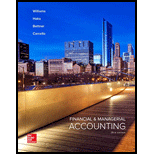
a.
Compute the missing amount using contribution margin per unit.
a.
Explanation of Solution
Contribution Margin:
The process or theory which is used to judge the benefit given by each unit of the goods produced is called as contribution margin.
The contribution margin is the difference between the selling price and the cost of the product.
Formula to compute the unit contribution margin:
| Sales | Variable Costs | Contribution Margin Ratio per Unit | Fixed Costs | Operating Income | Units Sold | ||
| (1) | $200,000 | $120,000 | $20 | $55,000 | $25,000 | 4,000 | |
| (2) | 180,000 | 105,000 | 15 | 45,000 | 30,000 | 5,000 | |
| (3) | 600,000 | 360,000 | 30 | 150,000 | 90,000 | 8,000 |
Table (1)
Working notes:
Calculate the amount of sales:
Step 1: Calculate the unit variable cost:
Step 2: Calculate the unit sales price:
Step 3: Calculate the amount of sales using contribution margin per unit:
Calculate the amount of variable costs using contribution margin per unit:
Calculate the amount of variable costs using contribution margin per unit:
Calculate contribution margin ratio per unit:
Step 1: Calculate unit variable cost.
Step 2: Calculate the unit sales price.
Step 3: Calculate contribution margin ratio per unit:
Calculate the amount of fixed costs:
Step 1: Calculate contribution margin.
Step 2: Calculate the amount of fixed costs.
Calculate the amount of units sold using contribution margin per unit:
b.
Compute the missing amount using contribution margin ratio.
b.
Explanation of Solution
Contribution Margin Ratio: The contribution margin ratio shows the amount of difference in the actual sales value and the variable expenses in percentage. This margin indicates that percentage which is available for sale above the fixed costs and the profit.
| Sales | Variable Costs | Margin Ratio (%) | Fixed Costs | Operating Income | ||
| (1) | $900,000 | $720,000 | 20% | $85,000 | $95,000 | |
| (2) | 600,000 | 360,000 | 40% | 165,000 | 75,000 | |
| (3) | 500,000 | 350,000 | 30% | 90,000 | 60,000 |
Table (1)
Working notes:
Calculate the contribution margin ratio:
Calculate the amount of fixed costs:
Step 1: Calculate contribution margin.
Step 2: Calculate the amount of fixed costs.
Calculate the amount of variable cost using contribution margin ratio:
Calculate the amount of fixed costs:
Step 1: Calculate contribution margin.
Step 2: Calculate the amount of fixed costs.
Calculate the amount of sales using contribution margin ratio:
Step 1: Calculate the amount of fixed costs.
Step 2: Calculate the amount of sales using contribution margin ratio:
Calculate the amount of variable cost using contribution margin ratio:
Want to see more full solutions like this?
Chapter 20 Solutions
Financial & Managerial Accounting
- Accurate answerarrow_forwardYork Digital has an accounts receivable turnover for the year of 7.5. Net sales for the period are $180,000. What is the number of days' sales in receivables?arrow_forwardABD Enterprises' total quick assets were $7,420,000, its current assets were $10,100,000, and its current liabilities were $6,800,000. Its acid-test ratio equals _.arrow_forward
- Can you help me solve this financial accounting question using valid financial accounting techniques?arrow_forwardAn item of equipment owned by Thurman Manufacturing cost $180,000 and had an estimated use of 75,000 hours. During the first 3 years, the equipment was used for 15,000, 13,500, and 12,000 hours. The equipment has an estimated life of 7 years and an estimated salvage value of $22,500.arrow_forwardGeneral accountingarrow_forward

 AccountingAccountingISBN:9781337272094Author:WARREN, Carl S., Reeve, James M., Duchac, Jonathan E.Publisher:Cengage Learning,
AccountingAccountingISBN:9781337272094Author:WARREN, Carl S., Reeve, James M., Duchac, Jonathan E.Publisher:Cengage Learning, Accounting Information SystemsAccountingISBN:9781337619202Author:Hall, James A.Publisher:Cengage Learning,
Accounting Information SystemsAccountingISBN:9781337619202Author:Hall, James A.Publisher:Cengage Learning, Horngren's Cost Accounting: A Managerial Emphasis...AccountingISBN:9780134475585Author:Srikant M. Datar, Madhav V. RajanPublisher:PEARSON
Horngren's Cost Accounting: A Managerial Emphasis...AccountingISBN:9780134475585Author:Srikant M. Datar, Madhav V. RajanPublisher:PEARSON Intermediate AccountingAccountingISBN:9781259722660Author:J. David Spiceland, Mark W. Nelson, Wayne M ThomasPublisher:McGraw-Hill Education
Intermediate AccountingAccountingISBN:9781259722660Author:J. David Spiceland, Mark W. Nelson, Wayne M ThomasPublisher:McGraw-Hill Education Financial and Managerial AccountingAccountingISBN:9781259726705Author:John J Wild, Ken W. Shaw, Barbara Chiappetta Fundamental Accounting PrinciplesPublisher:McGraw-Hill Education
Financial and Managerial AccountingAccountingISBN:9781259726705Author:John J Wild, Ken W. Shaw, Barbara Chiappetta Fundamental Accounting PrinciplesPublisher:McGraw-Hill Education





